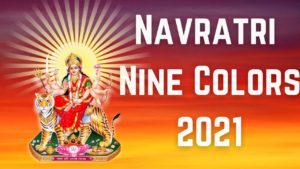What is Navaratri
Navaratri is a major Hindu festival celebrated by Hindus all over the world. The festival derives its name from two Sanskrit words, ‘Nava’ and ‘Ratri’ meaning, ‘nine’ and ‘nights.’ As the festival is celebrated for nine nights, it got the name, ‘Navaratri.’
The legend of Navaratri
Navaratri falls on the lunar month of Ashvin and marks the beginning of the winter season (September-October). The festival celebrates the victory of Goddess Durga, who had killed the demon Mahishashura after a nine-day-long battle. In South India, along with Goddess Durga, people also worship Goddess Laxmi and Goddess Saraswati.
As per another legend, Lord Rama worshipped Durga for nine days to obtain her power to slain Ravana. Then, the Goddess appeared before Lord Rama, gave him her power, and blessed him with boons. Finally, on the tenth day, he rescued Sita, and as a commemoration, these ten days are celebrated as Dusshera.
In West Bengal, people install statues of Ma Durga at their homes and in special pandars and perform puja for ten days, and after the festivities are over, they immerse the statues in waterways. The devotees believe that the Goddess comes from heaven and stays with them for ten days and then bids them goodbye and will be back the following year.
Why is Navaratri so special
Navaratri festival is dedicated to worshiping the female trinity of Hinduism, Goddesses, Saraswathi, Lakshmi, and Parvathi, the consorts of Lord Brahma, Lord Maha Vishnu, and Lord Mahadev, respectively.
The feminine form of divinity has equal status in Hinduism, and the Navaratri festival, in particular, is exclusively meant for the worship of the goddesses.
This festival is celebrated all over India, and the legends of the festival differ from one region to another. People of West Bengal, Karnataka, and Assam observe Navaratri in a grand manner.
5 strange Navaratri rituals
As Navaratri is a pan India festival, the rituals and practices of the festival differ depending on the region’s culture, tradition, and demography. Therefore, the rituals followed in one region are not observed in another. Here are the five strange Navaratri rituals.
The 9-Day Colour Code for dress:
In Maharashtra and Gujarat they follow a unique tradition; the devotees, especially the women, wear clothes as per the particular color of the day. The Women adorn themselves with similar color attires and accessories during this festival. Each day of the 9-day festival is dedicated to a particular color, and people carefully coordinate their festival wardrobe with the color theme.
The following is the color code practiced during the festival of Navratri:
Day 1: Red
Day 2: Blue
Day 3: Yellow
Day 4: Green
Day 5: Grey
Day 6: Orange
Day 7: White
Day 8: Pink
Day 9: Sky Blue
Worshipping weapons:
Ma Parvathi, one of the divine feminine trinity worshipped during Navaratri, is the Goddess of power and courage. She is also known as Sakthi and is worshipped in different forms like Durga, Chandi, and Kali. The devotees believe that invoking the goddess makes them strong and determined.
During olden times when monarchy existed in India, the monarchs, warriors, and soldiers worshipped Ma Durga by placing their weapons before her and sought her blessings to experience victory in any wars and duels. Even today, people belonging to the Kshatriya castes follow this custom. The kings also prayed to the Goddess before commencing a war.
Navaratri Kolu:
This tradition is unique to Tamil Nadu. ‘Kolu’ means doll, and during Navaratri, the dolls of Gods & Goddess, saints, temple miniatures, animals, birds, etc., are neatly arranged on a step-like structure and are worshipped for ten days.
The Kolu dolls are made of clay or wood. The number of steps in the Kolu stand is in multiples of odd numbers like 3,5,7,9 and so on. The women cook special snacks for the Kolu dolls for nine days and perform bhajans. The neighboring women are also invited to participate in the function, and the prasad is distributed to them. The women who attend the bhajans are given gifts such as cloth bits, bangles, kum kum etc.
Sondhi Puja:
Sondhi Puja is an important tradition followed during Durga Puja. It is performed during the last 24 minutes of Ashtami and the devotees worship Chamunda, an aggressive form of Goddess during this time.
During Sondhi Puja, a total of 108 diyas (lamps) are lit along with the same number of lotus flowers to celebrate the victory of Goddess Durga over Mahishasura, the buffalo-headed demon.
Sowing of barley:
Barley symbolizes prosperity, abundance, fertility, and growth and occupies a prominent place during the Navratri festival. Therefore, barley sown during this festival is considered a good omen. The farmers believe that the quality and length of the shoots will determine much wealth and prosperity the family will earn during the upcoming year.
« Why Mahalaya Amavasya is important This Navaratri, Chant Lalitha Sahasranama »
